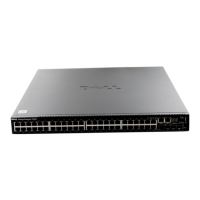Configuring SNMP 335
Configuring SNMP (CLI)
This section provides information about the commands you use to manage
and view SNMP features on the switch. For more information about these
commands, see the
PowerConnect 7000 Series CLI Reference Guide
.
Configuring the SNMPv3 Engine ID
To use SNMPv3, the switch must have engine ID. You can specify your own
ID or use the default string that is generated using the MAC address of the
switch. If the SNMPv3 engine ID is deleted, or if the configuration file is
erased, then SNMPv3 cannot be used. Since the EngineID should be unique
within an administrative domain, the following guidelines are recommended:
• For standalone switches use the default keyword to configure the Engine
ID.
• For a stack of switches, configure your own EngineID, and verify that is
unique within your administrative domain.
Changing the value of SNMP EngineID has important side-effects. A user's
password (entered on the command line) is converted to an MD5 or SHA
security digest. This digest is based on both the password and the local engine
ID. The command line password is then destroyed, as required by RFC 2274.
Because of this deletion, if the local value of engineID changes, the security
digests of SNMPv3 users will be invalid, and the users will have to be
reconfigured.
Beginning in Privileged EXEC mode, use the following commands to
configure an engine ID for SNMP.
Command Purpose
configure Enter Global Configuration mode
snmp-server engineID
local {
engineid-string
|
default}
Configure the SNMPv3 Engine ID.
• engineid-string — The character string that identifies the
engine ID. The engine ID is a concatenated hexadecimal
string. Each byte in hexadecimal character strings is two
hexadecimal digits. Each byte can be separated by a
period or colon. (Range: 6-32 characters)
• default — The engineID is created automatically, based
on the device MAC address.

